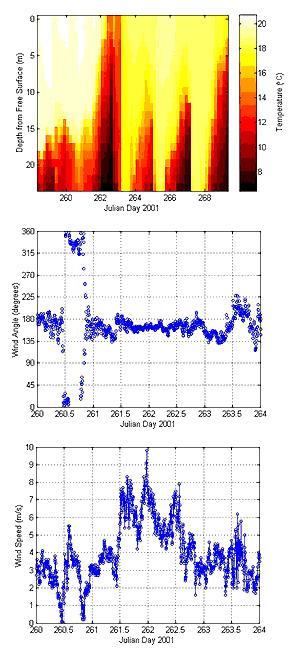Web site for Cornell's RUSS research-education project explains swimmers' confusion about why Cayuga blows hot and cold
By Roger Segelken

Anyone who swims on consecutive days in a large lake knows that the water can be pleasantly refreshing on one day and frightfully cold the next.
Now a remote underwater sampling station, or RUSS, instrument package, installed earlier this year in Cayuga Lake by Cornell University scientists and students, has documented a dramatic phenomenon to explain the swimmers' confusion: Strong, persistent winds cause large bodies of water to slosh back and forth -- like a bathtub in an earthquake -- and bring to the surface enough cold, deep water to make bathers wonder if they are in the same lake they enjoyed the day before.
"This rocking, sloshing motion is a well-known phenomenon in limnology [the study of lakes and other inland waters] called an internal seiche," explains Nelson Hairston Jr., the Rhodes Professor of Environmental Science who is one of the leaders of the Cornell RUSS research-education project. "But because of its long and deep basin, this lake does it better than most. Cayuga Lake really rocks!"
Evidence of the lake's internal seiche (pronounced "say-sh") can be found at the Cornell Center for the Environment web site by clicking on "water quality." The first picture shows how water temperature (in degrees Celsius), as depicted in different colors, decreases with lake depth, and how the pattern changes throughout the week. Looking across the top of the picture, surface water can be seen going from dark red (relatively warm) to lighter red (less warm). At 20 meters (65 feet) deep in the lake, the rocking is especially pronounced as water temperature goes from 18 C to 8 C (in Fahrenheit, 64 to 46) about every two days.
The Cornell RUSS is a yellow-painted, Y-shaped floating platform -- covered with antennas, weather instruments and photovoltaic solar panels -- that is moored in 80 feet of water some 2,000 feet offshore at the southern end of Cayuga Lake. Underwater instruments periodically descend as deep as 25 meters beneath the surface to measure not only water temperature but also turbidity (murkiness due to suspended sediment), biological activity (based on amounts of chlorophyll in algae) and dissolved salts and acidity. The RUSS data are displayed and archived on the web site for use by researchers as well as students and the general public.
Ecologist Hairston recounts a recent seiche event in the 35-mile-long lake that got the scientists' attention: "Last week, strong and persistent winds from the south blew the warm surface waters to the north end of the lake. There, the accumulation of warm water pushed down on the cold, deep water and caused it to rock up to the surface at the south end. After the winds died, the warm waters that had accumulated at the north end sloshed back to the south end, pushing the cold water back down. As a result the surface water temperature in the south end of the lake went from about 70 degrees Fahrenheit on Monday, Sept. 17, to 59 degrees the following Wednesday, then back to 68 on Friday."
Once the big "bathtub" rocking started, it continued for days, Hairston says: "The water kept sloshing back and forth with the warm surface water repeatedly rocking from north to south as the cold bottom water was rocking in the opposite direction. The really cold water that came to the surface is staying deeper now but still rocks up to the surface about every other day."
In addition to Hairston, the Cornell RUSS project is run by Edwin "Todd" Cowen, assistant professor of civil and environmental engineering, and Kristi Kull, a graduate student in that department. Gene Harquist is the web administrator for the Center for the Environment's lake-monitoring web site. Costs of the $150,000 project, including approximately $65,000 for the RUSS instrument, are covered by a gift from an anonymous donor, with additional support from Cornell.
Media Contact
Get Cornell news delivered right to your inbox.
Subscribe